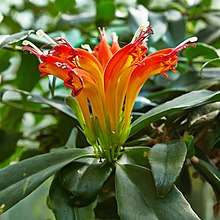Cyrtandroideae
The Cyrtandroideae are a subfamily of plants in the family Gesneriaceae,[1] with a typical genus being Cyrtandra; some authorities place these genera in the Didymocarpoideae. This subfamily consists mostly of tropical and subtropical Old World genera, found in Africa and Asia.
| Cyrtandroideae | |
|---|---|
.jpg) | |
| Cyrtandra grayi | |
| Scientific classification | |
| Kingdom: | Plantae |
| Clade: | Tracheophytes |
| Clade: | Angiosperms |
| Clade: | Eudicots |
| Clade: | Asterids |
| Clade: | Lamiids |
| Order: | Lamiales |
| Family: | Gesneriaceae |
| Subfamily: | Cyrtandroideae Burnett |
Tribes and genera
Wikispecies lists the following:
Cyrtandreae
- Cyrtandra
- Rhynchotechum
- Sepikea
Didymocarpeae

Didymocarpeae: Boea hemsleyana

Didymocarpus repens

Haberlea rhodopensis
- Achanthonema
- Allocheilos
- Allostigma
- Ancylostemon
- Anna
- Beccarinda (synonym Slackia is a bacterium)
- Boea
- Boeica
- Bournea
- Briggsia
- Briggsiopsis
- Calcareoboea
- Cathayanthe
- Championia
- Chirita
- Chiritopsis
- Colpogyne
- Conandron
- Corallodiscus
- Dayaoshania
- Deinocheilos
- Deinostigma
- Didissandra
- Didymocarpus
- Didymostigma
- Dolicholoma
- Gyrocheilos
- Haberlea
- Hemiboea
- Hemiboeopsis
- Henckelia
- Hexatheca
- Isometrum
- Jancaea
- Lagarosolen
- Leptoboea
- Linnaeopsis
- Loxocarpus
- Metabriggsia
- Metapetrocosmea
- Nodonema
- Opithandra
- Orchadocarpa
- Oreocharis
- Ornithoboea
- Paraboea (synonyms: Chlamydoboea Stapf, Phylloboea Benth.)
- Petrocodon
- Petrocosmea
- Phyllobaea
- Platyadenia
- Platystemma
- Primulina
- Pseudochirita
- Ramonda
- Raphiocarpus
- Rhabdothamnopsis
- Ridleyandra
- Saintpaulia
- Schizoboea
- Streptocarpus
- Tengia
- Tetraphyllum
- Thamnocharis
- Trachystigma
- Tremacron
- Trisepalum
Klugieae
Klugieae: Rhynchoglossum obliquum
- Epithema
- Gyrogyne
- Loxonia
- Monophyllaea
- Rhynchoglossum
- Stauranthera
- Whytockia
Trichosporeae

Trichosporeae: Aeschynanthus speciosus
- Aeschynanthus
- Agalmyla
- Loxostigma
- Lysionotus
- Microchirita
- Micraeschynanthus
- Oxychlamys
gollark: They can probably just quash anyone who complains with their large legal department.
gollark: They could probably have pulled a picture of "destroyed screen" or whatever off the internet, though.
gollark: Fun idea: a program to *simulate* cracked/punched screens.
gollark: <@701616503065280522> Looks like it. I've seen a TV shot with one of those toy bow and arrow things and it looked similar. Why do you ask?
gollark: Does the Markov chain operate on words or individual characters?
References
- Smith, JF (1998) in The Tree of Life Web Project: Gesneriaceae (Version 20 April 1998) - see Discussion of Phylogenetic Relationships (retrieved 15 February 2020)
External links


This article is issued from Wikipedia. The text is licensed under Creative Commons - Attribution - Sharealike. Additional terms may apply for the media files.